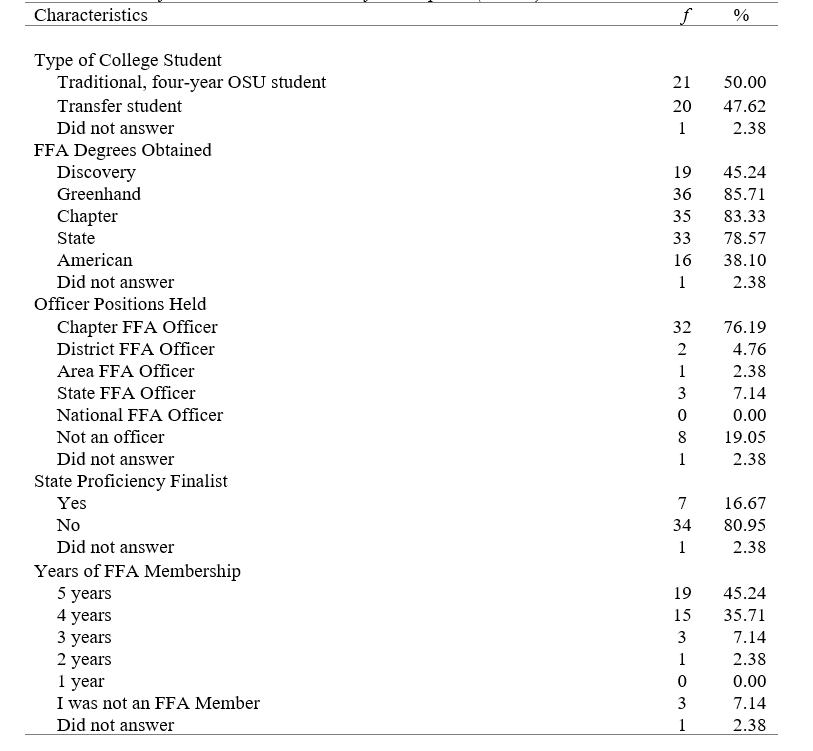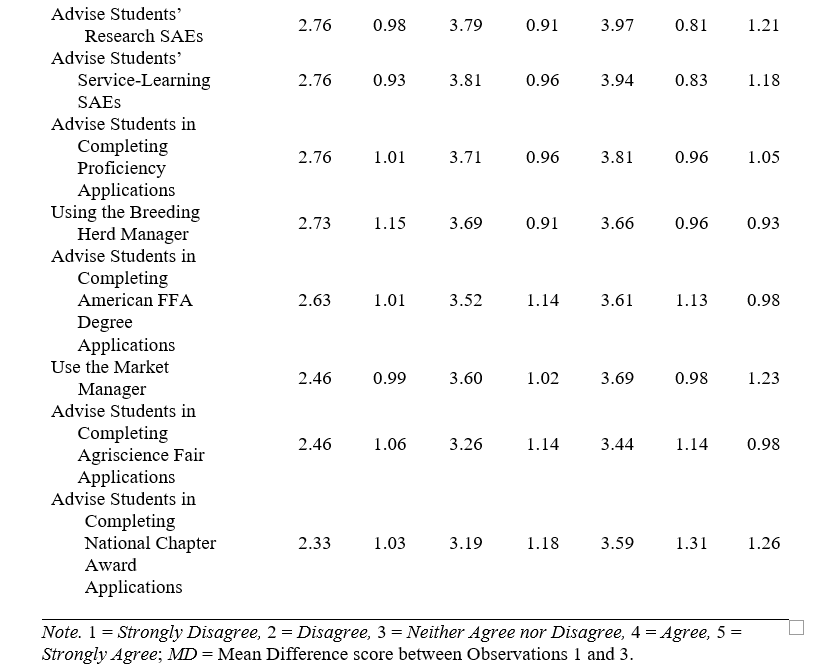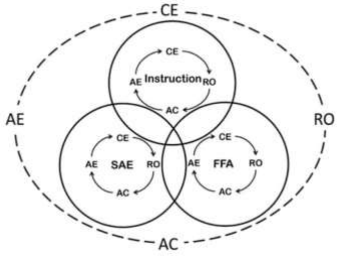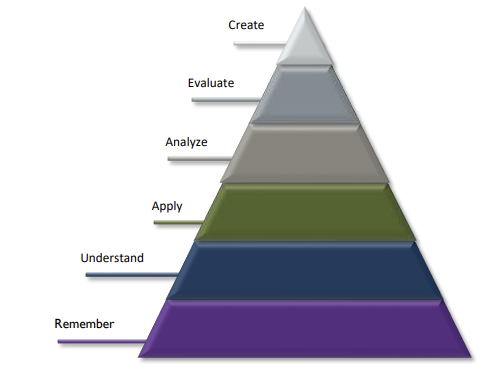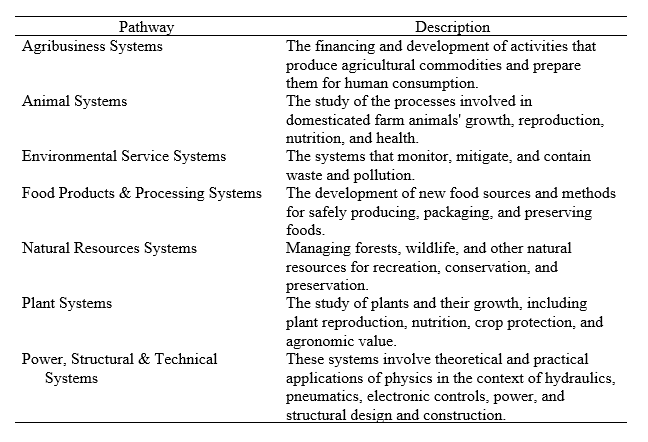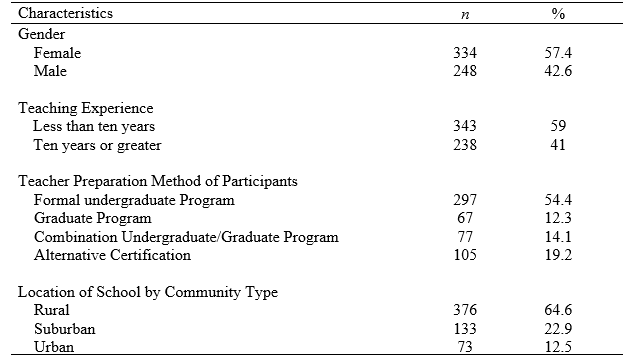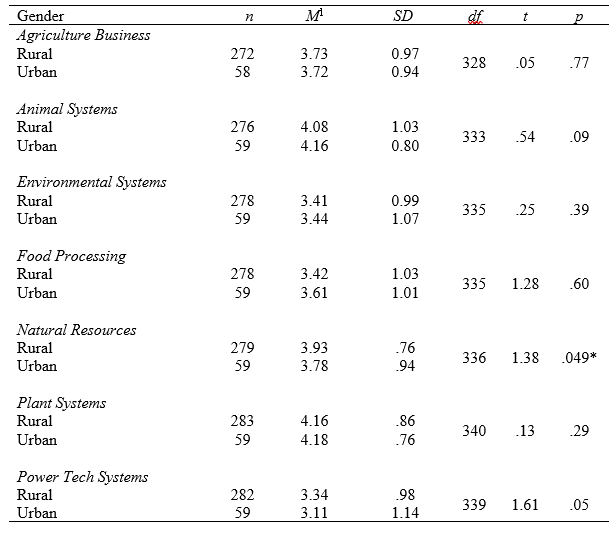Christopher M. Estepp, University of Arkansas, estepp@uark.edu
Bryan D. Rank, Arkansas Tech University, brank@atu.edu
Alyssa Johnson, Arkansas Department of Agriculture, alyssa.johnson@agriculture.arkansas.gov
Trent Wells, Murray State University, kwells23@murraystate.edu
Abstract
Public school teachers face many challenges, which can lead to stress, burnout, and potential attrition from the profession. Scholars have proffered that due to the unique nature of the profession, school-based agricultural education (SBAE) teachers might struggle with more challenges than their non-agricultural counterparts. Previous research has revealed many of the challenges faced by SBAE teachers; however, many of these challenges have focused on professional development or other teacher-centric issues. To ensure the viability and the future of SBAE, we must determine not only the current challenges facing teachers but those on the horizon for the overall profession as well. Therefore, the purpose of our study was to examine the perceived challenges facing Arkansas Agricultural Education over the next decade. Using Chapman’s model of teacher retention, we posited that the challenges faced by SBAE teachers could align with one of five factors in the model leading to teacher attrition. Focus groups were used to solicit data from current SBAE teachers in Arkansas regarding the challenges they perceive facing Arkansas over the next decade. Results showed that SBAE teachers currently face a wide range of perceived personal and professional challenges, and further, the Arkansas SBAE profession will face varying challenges in the coming years. Recommendations include agricultural teacher educators and Arkansas Department of Education staff working together to find practical solutions to mitigate some of the challenges facing Arkansas SBAE. Additionally, further research should be conducted to determine how these perceived challenges relate to teacher attrition.
Public education in the United States has faced countless challenges including a nationwide shortage of teachers, which has been a persistent, critical issue (Guffey & Young, 2020). School-based agricultural education (SBAE) has not been invulnerable to this shortage and has experienced a lack of qualified educators for many years (Boone & Boone, 2009; Camp, 2000; Eck & Edwards, 2019; Smith et al., 2022). Smith et al.’s (2022) most recent SBAE teacher supply and demand study revealed that between the 2020-2021 and the 2021-2022 academic years, 29 states reported losing SBAE programs or positions; specifically, 60 teaching positions were lost and 30 programs closed. Accordingly, Eck and colleagues (Eck & Edwards, 2019; Eck et al., 2021) voiced concern that the greatest threat facing SBAE will be the lack of quality teachers.
Conversations around this issue have centered on the recruitment, retention, and effectiveness of SBAE teachers. As a result of teacher shortages, many school administrators have been forced to close programs or look to alternatively-certified teachers as a means to help fill positions (Bowling & Ball, 2018). According to Smith et al. (2022), nearly one-third of new SBAE teachers hired for the 2021-2022 academic year (a) possessed an alternative teaching certification, (b) were non-licensed, or (c) their licensure status was unknown. Although alternatively-certified SBAE teachers have been found to possess high levels of skill in technical content, Bowling and Ball (2018) suggested that these teachers struggle with pedagogical effectiveness. The sustainability of SBAE programs is affected by teacher recruitment (Gates et al., 2020; Guffey & Young; 2020), retention (Lemons et al., 2015), and effectiveness (Eck et al., 2019, 2021; Roberts & Dyer, 2004), which are all influenced by the myriad challenges faced by SBAE teachers (Eck et al., 2019).
Many of the challenges faced by SBAE teachers are similar to those faced by teachers in other disciplines. However, due to the unique nature of the three-circle model of Agricultural Education (Croom, 2008), SBAE teachers tend to experience greater challenges resulting from the added responsibilities of FFA advisement and Supervised Agricultural Experiences (SAE; Eck et al., 2021). Boone and Boone (2009) conducted a modified Delphi study to determine challenges faced by beginning and veteran SBAE teachers in West Virginia. They concluded that financial compensation, paperwork, time management, and work/life balance were all issues. Work/life balance and time commitments have been perennial challenges faced by SBAE teachers. Torres et al. (2008) argued that SBAE teachers’ time commitments exceed that of core subject teachers leading to work/life balance struggles, high levels of stress, and burnout. These challenges among SBAE teachers have been well-noted (Smith & Smalley, 2018; Touchstone, 2014) and examined as contributors to teacher shortages (Graham et al., 2016; Smith & Smalley, 2018).
Beyond the aforementioned challenges, others have been prevalent as well. McKim and Sorensen (2020) noted that the recent COVID-19 global pandemic resulted in teachers “completely changing their work role while simultaneously adapting to completely restructured life roles” (p. 222), resulting in a considerable decline in job satisfaction. Recent literature described additional challenges related lack of effective boundary-setting (Haddad et al., 2023), juggling multiple professional and personal responsibilities (Traini et al., 2021), and dealing with limited self-efficacy when teaching (or preparing to teach) technical agriculture subject matter (Granberry et al., 2022; Whitehair et al., 2020).
Considering the previous literature, SBAE teachers clearly face a variety of challenges. Much of this literature has focused on the issues facing SBAE teachers at the classroom and personal level; however, little research has examined SBAE teachers’ perceptions of the challenges facing the larger SBAE profession. Thus, this presents an opportunity to examine the topic within the borders of Arkansas. No recent studies focusing on the challenges facing SBAE teachers and the broader SBAE system in Arkansas have been conducted. Doing so will help better inform the state’s SBAE stakeholders about the nature of the challenges facing Arkansas SBAE while concomitantly allowing researchers and state FFA staff to proactively tackle both the current and forthcoming challenges ahead.
Theoretical/Conceptual Framework
The theoretical lens for this qualitative study was social constructivism, which is the belief that through social interactions, consensus can be formed among a group about what constitutes knowledge (Ormrod, 2008). Hirtle (1996) posited that within the social context, individuals can reflect with others and create meaning-making in a democratic manner. In the context of this study, Arkansas SBAE teachers were asked to determine the perceived challenges they see facing SBAE in the state over the next ten years. This activity was conducted in a focus group setting allowing teachers to collectively reach consensus regarding the question.
Chapman’s (1983) model of teacher retention (Figure 1) was utilized as the conceptual framework, guiding the categorization of emergent themes. Chapman proposed several factors influence a teacher’s decision whether to stay or leave the profession. These factors were identified as: (a) personal characteristics of the teachers, (b) the nature of teacher training and early teaching experiences, (c) the degree to which the teacher is socially and professionally integrated into the teaching profession, (d) the satisfaction teachers derive from their careers, and (e) the external environmental influences impinging on the teacher’s career (Chapman, 1983).
In alignment with Chapman’s (1983) model, the factors pertaining to the challenges that teachers see facing the SBAE profession in Arkansas, should relate to external influences impinging upon the teacher’s career; however, these challenges can be multifaceted and touch multiple areas of teachers’ personal and professional lives. Internal and external challenges faced by teachers can have a direct impact on teacher attrition (Chapman, 1983) and examining the challenges teachers see facing the profession in the context of Chapman’s model can help build an understanding of why they might leave the classroom. According to Chapman (1983), discerning the characteristics of teacher attrition can influence policies set forth by administrators and how teacher preparation programs prepare their students. Ultimately, this study focused on SBAE teachers’ perceived challenges in hopes to better understand SBAE teacher attrition.
Figure 1
A Model of the Influences on Teacher Retention (Chapman, 1983)
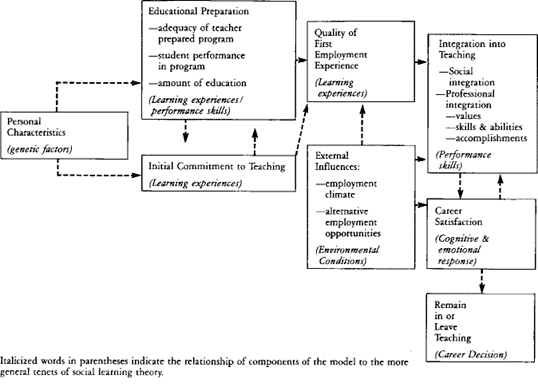
Purpose
SBAE teacher recruitment, retention, and effectiveness are important factors in the sustainability of SBAE. Many studies have revealed the challenges faced by SBAE teachers, which can affect teacher recruitment, retention, and effectiveness; however, much of the research is dated and has focused on professional development needs and other teacher-centric issues. To ensure the viability and the future of SBAE, we must determine not only the current challenges facing teachers but those on the horizon for the overall profession as well. Therefore, the purpose of this study was to examine the perceived challenges facing Arkansas Agricultural Education over the next decade. The research question guiding this study was: What issues do Arkansas SBAE teachers perceive as being prominent in Agricultural Education in Arkansas over the next ten years?
Methods
The available population for this study was all in-service SBAE teachers in the State of Arkansas. E-mail invitations were sent via the Arkansas SBAE teacher email listserv to recruit focus group participants, and each teacher who responded was asked to select the focus group timeslot best aligning with their schedule; no incentives were offered to teachers. Ten SBAE teachers who had all taught for at least one academic year, represented different regions of the state and varying program, school, and community sizes and orientations. One limitation of the study was that only one SBAE teacher from the Eastern District participated; characteristics of participants are shown in Table 1. Three focus groups were conducted during the Spring 2022 semester to engage participants in an open-ended discussion about challenges they perceived affecting the SBAE profession. Additionally, participants were provided the opportunity to propose possible solutions to their concerns.
Table 1
Characteristics of Focus Group Participants
| Participant | Gender | Years Teaching | Size of SBAE program | District |
| Participant 1 | Female | 11 | Single-teacher | Northwest |
| Participant 2 | Male | 4 | Multi-teacher | Northwest |
| Participant 3 | Female | 15 | Single-teacher | Northwest |
| Participant 4 | Male | 23 | Multi-teacher | Northwest |
| Participant 5 | Male | 13 | Single-teacher | Southern |
| Participant 6 | Female | 10 | Single-teacher | Southern |
| Participant 7 | Female | 6 | Single-teacher | Southern |
| Participant 8 | Female | 3 | Multi-teacher | Southern |
| Participant 9 | Male | 1 | Multi-teacher | Southern |
| Participant 10 | Female | 6 | Single-teacher | Eastern |
The theoretical lens of social constructivism allowed for the use of a focus group approach to collect data (Flick, 2006) enabling participants to socially construct their knowledge regarding the challenges facing Arkansas SBAE over the next decade. Focus groups were conducted using Zoom™ video-conferencing software and the software’s internal transcription feature was used to create a verbatim transcript. A semi-structured interview format was used for each focus group, during which the initial question, “What do you see as the biggest challenges facing Arkansas Agricultural Education over the next 10 years?” was asked. Follow-up probing questions were utilized to encourage conversation and increase the richness of the data (Merriam, 2009; Seidman, 2006). As the conversation evolved, a second question pertaining to how state staff, agricultural teacher educators, and SBAE teachers could collectively help mitigate these challenges was posed. Upon the conclusion of all focus groups, the transcripts were checked and compiled and sent to participants for member checking to ensure the participants’ statements were accurately represented.
Data were independently organized and categorized thematically using two distinct methods of data analysis. First, data were inductively analyzed and coded using the constant-comparative method (Glaser & Straus, 1967) whereby data were grouped into codes and emergent themes and labels were assigned to each. Subsequently, the deductive a priori template of codes method recommended by Crabtree and Miller (1999) was used to compare the emergent themes to Chapman’s (1983) model of teacher retention. Themes congruent with Chapman’s (1983) model were aligned under the applicable model component, while newly emergent themes were presented as potential new components. Once themes were assigned by each individual researcher, the group met to determine the consensus for the final themes.
Each researcher has been involved in agricultural education in various capacities; three of the researchers are agricultural teacher educators with over 25 years of combined experience between secondary and postsecondary agricultural education and one researcher was, at the time of our study, a graduate student involved in agricultural teacher education at the University of Arkansas. To minimize threats to trustworthiness, personal biases were bracketed through conversations, and self-identification of biases was made prior to independent coding. Member checking was used throughout to ensure the participants’ original intent was communicated through the data and subsequent themes.
Findings
Initial use of inductive coding (Glaser & Straus, 1967) revealed eleven emergent themes from the transcripts of the three focus groups. These themes were: (1) Changing Demographics; (2) Community and Administrative Support; (3) Content Knowledge; (4) Interpersonal Relationships; (5) Pandemic Recovery; (6) Professional Development/Resources; (7) Nature of SBAE Programs; (8) Recruiting New Teachers; (9) Retaining Teachers; (10) Stress; and (11) Teacher Recognition/Appreciation. These emergent themes were then categorized deductively (Crabtree & Miller, 1999) within the components of Chapman’s (1983) model. The themes fit within Personal Characteristics, Educational Preparation, External Influences, Integration into Teaching and Career Satisfaction components. Additionally, the theme of Recruiting New Teachers emerged from the focus groups and was included as a stand-alone theme.
Personal Characteristics
Changing Demographics
The changing demographics theme included a discussion of the shift from a male-dominated profession to an increasingly female profession. In particular, participants indicated that early- and mid-career teachers are increasingly female and a smaller number of males are choosing to enter preservice teacher education programs. Nonetheless, participants indicated that good teachers are needed and that gender identity was not an indicator of one’s ability to teach. Considering the changing demographic, one participant said, “We are starting to be more female dominated… I feel like we’ve worked really, really, really hard to recruit women into our profession, so we can be more diverse, so we had women representing us I feel like we hardly have any males pursuing the degree,” whereas another participant stated, “I think good teachers are good teachers, whether they’re female or male.” Another participant added, “I don’t think it matters if it’s male or female, like that’s a very good point that a good teacher is good teacher, so I don’t know.” However, there was a concern expressed by Participant 8, who commented, “I worry that we’re not recruiting males as much as we should be now.”
Educational Preparation
Content Knowledge
The content knowledge of preservice and early-career teachers was a concern among the focus group participants. They cited young teachers’ lack of experience and preservice teacher programs’ lack of coursework in certain agricultural content areas. Specifically, knowledge in the agricultural mechanics pathway was described as an area lacking in agricultural teacher education programs. Participant 3 stated, “Ag[ricultural] mechanics has been a huge thing that has changed in the last 10 years. Interns coming out of college lack just the basic knowledge of things in the shop.” A female participant related the gender issue to content knowledge; “So when we think about that typically males are more ag[rigultural] mechanics-heavy, and now all I teach is [agricultural] mechanics, and so I’m worried.”
Professional Development/Resources
Professional development/resources was a theme that included continuing education, as well as sharing of curriculum resources. The participants indicated a need for continuing education from the Arkansas Department of Education, as well as the agricultural teacher education programs in the state. A representative statement from one participant was, “But the things like [TEACHER’S] ladies-only ag[ricultural] mech[anics] workshop, I love that. Or, what I would have loved was Dr. Wells’s Briggs and Stratton workshop, but I got COVID… Giving us more opportunities to break off into those areas where we’re not as strong as far as Team AgEd on the state level, making more of those opportunities known, and, as far as administrative level just supporting us and more PD funds.”
Nature of SBAE Programs
The nature of SBAE programs was a theme which described the multitude of activities occurring within local SBAE programs. This theme included an expression of the need for preservice and early-career teachers to be prepared for the non-academic responsibilities of a SBAE teacher. Fundraising, in particular, was mentioned as one area needing to be addressed in more detail in agricultural teacher education programs. One participant stated, “So fundraising and working with it, that’s gotta be more than just bringing in somebody and saying, you know, ‘sell my product’.” Additionally, participants suggested ways to help preservice teachers learn these types of activities. When working with prospective SBAE teachers, one participant said, “And then I started thinking about it in a different light and showing them the behind the scenes of it; taking those kids along with me on the Lowe’s runs when I have to buy way too much stuff; taking a student who wants to be an ag[riculture] teacher to the fair even though she’s not showing animals. Just grabbing onto those students and giving them as many opportunities as possible even if they’re not necessarily involved in what’s going on.”
External Influences
Community and Administrative Support
Community and administrative support was described as an essential part of a successful program. Building relationships with stakeholders in the community was described as a way to overcome barriers with school structure and administration. However, teachers discussed challenges overcoming administrators’ traditional perceptions of SBAE and FFA, which make it difficult to implement more progressive components in some of their programs. One participant said, “I don’t know how to solve that problem, but selling our programs and getting our programs supported administratively at the local level can have as much of an impact as anything, in my opinion.” While Participant 5 added, “. . .[T]ake [SCHOOL]. . .They’ve had issues in the past with bad administration, or I shouldn’t say bad, but you know, not as supportive, and they’ve pulled the Alumni card, the supporter card, and got the community involved. Even though, they’re really a small group that supports their program.” Participants indicated that they have seen a large turnover in administrators in the past few years. They described cultivating support from administrators as an ongoing challenge. However, they said that supportive administrators also can make the job of teaching more enjoyable and rewarding. Participant 3 mentioned, “The changeover in administrators in Arkansas has been a big shift. . . I feel like in all these years, 15 years of teaching, I’ve seen the switchover of administrators from barely coming into your classroom and barely worrying about what your students are doing. And, the whole teaching bell-to-bell at some schools has not really been a thing, and then I come to a school like I’ve been at the last, you know, six to 10 years and that is a big deal.”
Stress
Stress was cited as a consistent challenge among the participants. When discussing stress, participants mentioned the frequency with which change happens in school districts and the lack of training when changes occur. While pandemic-related change was discussed with this challenge, participants mentioned already being stressed by changes at the district, state, and national levels. As Participant 1 explained, “Okay, don’t change things; it’s changing too much already, you know. Don’t! If anything, you know, give us a chance to learn how to deal with what we’re already dealing with. . . Okay, let me get adjusted to where I’m at and what I’m doing, and let me think for a while. You know, if anything, we just need more knowledge on how to get through what we’re going through right now.”
Integration into Teaching
Interpersonal Relationships
Interpersonal relationships were discussed as a challenge in the focus groups. Participants indicated that interpersonal relationships are important in the Agricultural Education profession; however, the pandemic limited teachers’ ability to meet in-person and foster these relationships. Participants included suggestions for formal and informal opportunities allowing teachers to meet and share ideas. Formal mentoring of early career teachers was discussed, as well as, mentoring that grows organically through informal interactions between experienced and inexperienced teachers. An additional suggestion was that experienced SBAE teachers conduct panel discussions where young teachers could get to know them. Essentially, the focus group participants indicated a desire to simply reconnect with one another and build professional relationships. One participant said, “It builds that camaraderie as well, and bringing in the young ones, and letting them build those relationships.” Another participant added, “That hanging-out conversation at lunch and then from 5:00 P.M. until we all finally go to bed. Those for me, are the most beneficial times, because then we can talk, we discuss what’s going on in class, we share ideas. I think it’s one of the most beneficial times we have, because for a lot of schools, like you know me I’m a one teacher, I have nobody… Because I’m a face-to-face conversation kind of person. I can post things in that Facebook group and ask for help. But it’s not the same as when you sit down in a room with somebody or at a picnic table at 10:00 at night at in-service and just talk about what works and what doesn’t work.”
Teacher Recognition/Appreciation
The second theme regarding Integration into Teaching was lack of teacher recognition/appreciation. While it was mentioned that many teachers do a good job promoting their students’ activities, the need exists to promote teachers in order to showcase the profession and recognize the contributions of effective teachers, who might otherwise go unnoticed. Social media was mentioned as one tool that could be used to highlight the exceptional activities teachers are doing in their local programs. One participant linked this lack of recognition to lack of community support and teachers’ self-esteem; “So, I think one of the biggest struggles and biggest challenges is getting our programs to be supported in our own communities, in our own school, because that builds our esteem, as our, as a profession, that makes us want to be at work or not, makes us want to do better with our kids, and be able to do better with our kids.” Another participant suggested using FFA as a mechanism to help recognize teachers. “When we think about National FFA, we think about the state FFA organization, and social media sites, and that sort of stuff, that’s focused and geared towards kids. I think students just need to see a different perspective.” The participants agreed that a broader perspective of the profession should be showcased.
Career Satisfaction
Retaining Teachers
Retaining teachers was a theme that described challenges faced by teachers in all phases of their careers. While specific challenges were identified that could lead to teacher attrition, love of teaching and helping students was cited as the reason the participants remained in the profession. Interestingly, it was mentioned that teachers who do not love students and teaching should leave the profession. As one participant opined, “I think retention is a big deal. You see teachers getting out anywhere from the beginning, to, you know, not even finishing the full retirement. It’s crossed, I think a lot of our minds, that I could be doing something else at any point time when we have a bad day; that we could do this and make a lot more money and not have to deal with near the headache.”
Recruiting New Teachers
Recruiting new teachers was a major concern among the participants. They pointed to teacher shortages in Arkansas and suggested the need to better utilize programs such as the National Teach Ag Campaign and Career Development Events as mechanisms to recruit students into agricultural teacher preparation programs. The participants recommended that teacher preparation programs use every opportunity to host prospective students on campus and highlight their Agricultural Education programs. They mentioned that welding schools have done a great job recruiting and have poached many students who may have been potential SBAE teachers. Beyond university recruiting, the participants also spoke about modeling the job of teaching. They mentioned taking students with them to purchase supplies and other routine tasks to give students a fuller picture of the job. Participant 2 said, “Number one, welding schools are killing our kids, not, and I don’t mean that literally, but they’re stealing away all of the good ones. And, why and how; and I’ve wondered that… But, I think those individuals [welding school recruiters] come into our classrooms and they are so passionate and so driven to say you need to be in this because we need you, we need you in this profession.” Participant 4 added, “I feel like every one of our major colleges in our state: [UNIVERSITIES], even [UNIVERSITY] now is doing CDEs on campus, but I don’t know if any of them are taking the time to turn it into a legitimate recruitment opportunity that it could and should be.” The Recruiting New Teachers theme did not fit neatly into Chapman’s (1983) components, so after consideration a new category linking Personal Characteristics with Initial Commitment to Teaching was created.
Conclusions, Discussion, and Recommendations
The purpose of this study was to examine the perceived challenges facing Arkansas Agricultural Education over the next decade. Findings indicated that participants foresee a wide range of perceived personal and professional challenges, and further, the Arkansas SBAE profession will likely face varying challenges in the coming years. These findings were not unexpected, as other scholars (i.e., McKim & Sorensen, 2020; Smith & Smalley, 2018; Touchstone, 2014) have also reported that SBAE teachers face a multitude of challenges. However, the alignment of perceived challenges with all five factors of Chapman’s (1983) model was interesting. Accordingly, agricultural teacher educators and Arkansas Department of Education staff should be equipped to address many of the challenges, particularly those pertaining to the nature of teacher training, early-career teaching experiences, and some external challenges (Chapman, 1983). Providing opportunities to better support teachers and recognize their efforts is crucial to the sustainability of SBAE both as a career path and as a profession.
Regarding specific technical agricultural subject matter knowledge, agricultural mechanics was frequently identified as a point of difficulty for many of the participants. Successfully teaching agricultural mechanics requires a range of expertise in numerous content areas and can often be a challenge for many SBAE teachers (Wells et al., 2021), so this finding was not completely unexpected. This finding was especially interesting, though, as agricultural mechanics coursework is required within all four active agricultural teacher education programs in Arkansas. However, the quality and scope of agricultural mechanics coursework likely varies between each university’s program based on faculty expertise, course offerings, and resource availability.
Participants also indicated a desire for: (1) improved preparation to teach agricultural mechanics via preservice level coursework and (2) additional in-service level professional development in agricultural mechanics. Confidence to teach their curricula, particularly technical agriculture subject matter, has been a top factor influencing SBAE teachers’ decisions to remain in the profession (Solomonson et al., 2021). While SBAE teachers need a range of knowledge and skills in various technical agriculture areas, such as animal science (Wells et al., 2023) and plant science (Solomonson et al., 2022), preparing SBAE teachers to teach agricultural mechanics has been a high priority (Granberry et al., 2023). Consequently, SBAE stakeholders in Arkansas should give attention to improving SBAE teachers’ confidence and competence to teach agricultural mechanics. Doing so may help to combat, at the minimum, some underlying issues facing Agricultural Education in Arkansas.
Our findings suggest perhaps Chapman’s (1983) model might be revisited. The SBAE teachers who participated in this study indicated the recruitment of new SBAE teachers is directly impacted by personal characteristics (e.g., family dynamics, familial support of career path decisions, etc.) and certain external influences. Specific external influences noted by participants related to the employment climate, including the current reputation of the teaching profession, and alternative employment opportunities, such as skilled trades-focused careers for prospective SBAE teachers. Personal characteristics were also identified as consequential to prospective SBAE teachers’ initial commitment to teaching. Further, the recruitment of prospective SBAE teachers was noted as directly influencing the individuals’ initial commitment to teaching and their personal characteristics. Consequently, we revised a portion of Chapman’s (1983) original model to account for this new and impactful information (see Figure 2).
Figure 2
Revised Portion of the Model of the Influences on Teacher Retention

In light of these conclusions, we recommend: (1) conducting additional research in Arkansas to identify pragmatic ways to address the identified challenges, (2) engaging with Arkansas SBAE stakeholders at all levels to confront the challenges within our control, and, (3) examining the relationship of these perceived challenges to SBAE teacher attrition. Additional research may yield greater insight into the complexities and nuances of confronting the identified challenges. In particular, replication of this study at regular intervals may be useful in determining how the identified challenges evolve over time. Considering the COVID-19 pandemic is no longer an international public health emergency (World Health Organization, 2023), some of the challenges identified (i.e., pandemic recovery and stress) may evolve or even become nonexistent in future replications. An additional recommendation was that other agricultural teacher educators outside Arkansas consider replicating this study. Doing so may help identify current and forthcoming challenges related to SBAE teachers and the SBAE profession in their respective states.
While Arkansas SBAE stakeholders may not be able to meaningfully address all the challenges identified in this study, there are certain practical steps that can be taken by these individuals to help mitigate some challenges identified by participants (e.g., reducing the frequency of changes to FFA-related activities, improving the quantity of agricultural mechanics-related PD offered to Arkansas teachers, etc.). Consequently, working closely with Arkansas SBAE teachers may help to stimulate discussion and impactful action. These findings will be shared with Arkansas Department of Education staff and the other agricultural teacher educators in Arkansas who were not directly involved with this study to help bring about awareness of the identified challenges and allow them to begin strategizing solutions.
While we acknowledge the findings of this study cannot be generalized beyond the teachers who participated, Johnson and Shoulders (2017) posited that, “Studies yielding valid results of interest to the profession from a specific groups [sic] of respondents, regardless of their generalizability, can add to the body of knowledge and assist researchers as they design and conduct research” (p. 310-311). Accordingly, these data hold practical implications for Arkansas SBAE stakeholders, particularly in the context of helping anticipate and tackle the present and future challenges faced by the SBAE profession. Considering long-term trends in public education and in SBAE, teacher attrition is a factor too important to ignore (Chapman, 1983; Eck & Edwards, 2019; Solomonson et al., 2021); the long-term sustainability of Arkansas SBAE depends upon the actions taken today.
References
Boone, H. N., & Boone, D. A. (2009). An assessment of problems faced by high school agricultural education teachers. Journal of Agricultural Education, 50(1), 21-32. https://doi.org/10.5032/jae.2009.01021
Bowling, A. M., & Ball, A. L. (2018). Alternative certification: A solution or an alternative problem? Journal of Agricultural Education, 59(2), 109-122. https://doi.org/10.5032/jae.2018.02109
Camp, W. G. (2000). A national study of the supply and demand for teachers of agricultural education in 1996-1998. Association for Career and Technical Education. https://files.eric.ed.gov/fulltext/ED458358.pdf
Chapman, D. W. (1983). A model of the influences on teacher retention. Journal of Teacher Education, 34, 43-49.
Crabtree, B., & Miller, W. (1999). A template approach to text analysis: Developing and using codebooks. In B. Crabtree & W. Miller (Eds.), Doing qualitative research (pp 163-177). Sage.
Croom, D. B. (2008). The development of the integrated three-component model of agricultural education. Journal of Agricultural Education, 49(1), 110-120. https://doi.org/10.5032/jae.2008.01110
Eck, C. J., & Edwards, M. C. (2019). Teacher shortage in school-based agricultural education (SBAE): A historical review. Journal of Agricultural Education, 60(4), 223-239. https://doi.org/10.5032/jae.2019.04223
Eck, C. J., Robinson, J. S., Ramsey, J. W., & Cole, K. L. (2019). Identifying the characteristics of an effective agricultural education teacher: A national study. Journal of Agricultural Education, 60(4), 1-18. https://doi.org/10.5032/jae.2019.04001
Eck, C. J., Robinson, J. S., Cole, K. L., Terry Jr., R. T., & Ramsey, J. W. (2021). Identifying the characteristics of effective school-based agricultural education teachers: A national census study. Journal of Agricultural Education, 62(3), 292-309. https://doi.org/10.5032/jae.2021.03292
Flick, U. (2006). An introduction to qualitative research (3rd ed.). Sage Publications.
Gates, H. R., Borges, B. D., & Shoulders, C. W. (2020). Tagged to teach ag day: Evaluating the influence of a recruitment event on students’ perceptions of campus climate. Journal of Agricultural Education, 61(2). 222-237. https://doi.org/10.5032/jae.2020.02222
Glaser, B. G., & Straus, A. L. (1967). The discovery of grounded theory: Strategies for qualitative research. Aldine.
Graham, D. L., Arnold, S., & Jayaratne, K. S. U. (2016). Research priority 6: Vibrant, resilient communities. In T. Roberts, A. Harder, & M. Brashears (Eds.), American Association for Agricultural Education National Research Agenda (pp. 49 – 56). http://aaaeonline.org/resources/Documents/AAAE_National_Research_Agenda_2016- 2020.pdf
Granberry, T., Blackburn, J. J., & Roberts, R. (2023). The state of agricultural mechanics in the preparation of school-based agricultural education teachers. Journal of Agricultural Education, 64(4), 144-158. https://doi.org/10.5032/jae.v64i4.160
Granberry, T., Roberts, R., & Blackburn, J. J. (2022). “A challenge that I’m willing to take on:” The self-efficacy of female undergraduate students in agricultural mechanics. Journal of Agricultural Education, 63(3), 44-58. https://doi.org/10.5032/jae.2022.03044
Guffey, K. B., & Young, J. S. (2020). Recruitment and retention of agriculture teachers in the southeast: An empirical analysis of the STAR program. Journal of Agricultural Education, 61(4), 203-213. https://doi.org/10.5032/jae.2020.04203
Haddad, B., Traini, H., & McKim, A. (2023). We’ve crossed a line: A philosophical examination of systemic implications surrounding SBAE teachers’ attempts at boundary setting. Journal of Agricultural Education, 64(1), 82-95. https://doi.org/10.5032/jae.v64i1.31
Hirtle, J. S. P. (1996). Social constructivism. English Journal, 85(1), 91.
Johnson, D. M., & Shoulders, C. W. (2017). Power of statistical tests used to address nonresponse error in the Journal of Agricultural Education. Journal of Agricultural Education, 58(1), 300-312. https://doi.org/10.5032/jae.2017.01300
Lemons, L. L., Brashears, M. T., Burris, S., Meyers, C., & Price, M. A. (2015). Factors contributing to attrition as reported by leavers of secondary agriculture programs. Journal of Agricultural Education, 56(4), 17-30. https://doi.org/10.5032/jae.2015.04017
McKim, A. J., & Sorensen, T. J. (2020). Agricultural educators and the pandemic: An evaluation of work and life variables. Journal of Agricultural Education, 61(4), 214-228. https://doi.org/10.5032/jae.2020.04214
Merriam, S. B. (2009) Qualitative research: A guide to design and implementation. Josey-Bass.
Ormrod, J. E. (2008). Human learning (5th ed.). Pearson.
Roberts, T. G., & Dyer, J. E. (2004). Characteristics of effective agriculture teachers. Journal of Agricultural Education, 45(4), 82-95. https://doi.org/10.5032/jae.2004.04082
Seidman, I. (2006) Interviewing as qualitative research: A guide for researchers in education. Teachers College Press.
Smith, A. R., Foster, D. D., & Lawver, R. G. (2022). National agricultural education supply and demand study, 2021 executive summary. American Association for Agricultural Education. https://aaaeonline.org/resources/Documents/2021%20NSD%20Executive%20Summary.pdf
Smith, A. R., & Smalley, S. W. (2018). Job stress, burnout, and professional development needs of mid-career agricultural education teachers. Journal of Agricultural Education, 59(2), 305-320. https://doi.org/10.5032/jae.2018.02305
Solomonson, J. K., Still, S. M., & Maxwell, L. D. (2021). Factors influencing the decision of Illinois school-based agricultural education teachers to remain in the profession. Journal of Agricultural Education, 62(3), 121-137. https://doi.org/10.5032/jae.2021.03121
Solomonson, J. K., Wells, T., Hainline, M. S., Rank, B. D., Wilson, M., Rinker, S. P., & Chumbley, S. B. (2022). Technical agriculture skills teachers need to teach courses in the plant systems pathway. Journal of Agricultural Education, 63(3), 100-116. https://doi.org/10.5032/jae.2022.03100
Touchstone, A. J. L. (2014). Challenges facing beginning agricultural education teachers in Idaho as perceived by beginning teachers, veteran teachers, and building administrators: A Delphi study. Proceedings of the Western Region American Association for Agricultural Education Conference. http://aaaeonline.org/Resources/Documents/Western%20Region/WRAAAE%20Proceedings.pdf#page=30
Torres, R. M., Ulmer, J. D., & Aschenbrener, M. S. (2008). Workload distribution among agriculture teachers. Journal of Agricultural Education, 49(2), 75-87. https://doi.org/10.5032/jae.2008.02075
Traini, H. Q., Haddad, B., Stewart, J., & Velez, J. J. (2021). Adjusting, appeasing, and rearranging: How agriculture teachers reconcile the demands of the profession. Journal of Agricultural Education, 62(2), 167-184. https://doi.org/10.5032/jae.2021.02167
Wells, T., Hainline, M. S., Rank, B. D., Sanders, K. W., & Chumbley, S. B. (2021). A regional study of the agricultural mechanics knowledge and skills needed by school-based agricultural education teachers. Journal of Agricultural Education, 62(2), 148-166. https://doi.org/10.5032/jae.2021.02148
Wells, T., Solomonson, J. K., Hainline, M. S., Rank, B. D., Wilson, M., Rinker, S. P., & Chumbley, S. B. (2023). Technical agriculture skills teachers need to teach courses in the animal systems pathway. Journal of Agricultural Education, 64(3), 158-175. https://doi.org/10.5032/jae.v64i3.117
Whitehair, R. L., Schramm, K. R. S., Wells, T., & Hainline, M. S. (2020). Preservice teachers’ conceptualizations of agricultural mechanics. Journal of Agricultural Education, 61(3), 60-74. https://doi.org/10.5032/jae.2020.03060
World Health Organization. (2023, May 5). Statement on the fifteenth meeting of the IHR (2005) Emergency Committee on the COVID-19 pandemic. https://www.who.int/news/item/05-05-2023-statement-on-the-fifteenth-meeting-of-the-international-health-regulations-(2005)-emergency-committee-regarding-the-coronavirus-disease-(covid-19)-pandemic?adgroupsurvey={adgroupsurvey}&gclid=EAIaIQobChMIv8PGParticipant 6b_wIVjTjUAR2YWAR2EAAYASABEgKag_D_BwE

